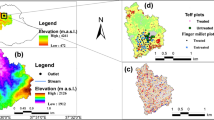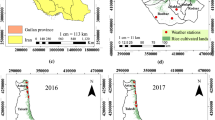Abstract
Yield predictions prior to harvesting crops is significant for agricultural decision-making. This study aimed to predict rice yield at the stage prior to harvesting using crops and soil phenological properties in the Pathein District of Myanmar. Remote sensing imagery data derived from Sentinel-2A satellite imageries during the month of November at the stage prior to harvest of rice fields were collected and analyzed from 2016 to 2021. Four vegetation indices (VIs): (i) normalized difference vegetation index (NDVI), (ii) normalized difference water index (NDWI), (iii) soil-adjusted vegetation index (SAVI), and (iv) rice growth vegetation index (RGVI) were specified as independent variables for a rice yield prediction model, after which simple and multiple linear regression models were estimated and validated. The accuracy of the estimated models was assessed using observed data from 1790 ground reference points (GRPs) in rice-yielding croplands. The average observed rice yield over 6 years was 1.57 tons per acre, and the average rice yield predictions over 6 years were 1.28, 1.48, 1.28, and 1.17 per acre with simple linear regression models from NDVI, NDWI, SAVI and RGVI, respectively. On the other hand, THE observed rice yield was 1.49 tons per acre with a multiple regression model. This indicates that prediction by the multiple regression model with four vegetation indices is superior to predictions by all other linear regression models. The early predicted yield data is useful for rice-growing farmers to compare expenses against losses after any extreme climatic event.
















Similar content being viewed by others
Data availability
The datasets analyzed in this study can be available from the corresponding author upon reasonable request.
References
Adeniyi OD, Szabó A, Tamás J, Nagy A (2020) Wheat yield forecasting based on Landsat NDVI and SAVI time series.
Arab ST, Noguchi R, Ahamed T (2022) Yield loss assessment of grapes using composite drought index derived from landsat OLI and TIRS datasets. Remote sensing applications: society and environment. Springer Nature Singapore
Camps-Valls G, Campos-Taberner M, Moreno-Martínez A, Walther S, Duveiller G, Cescatti A, Mahecha MD, Muñoz-Maríl J, García-Haro FJ, Guanter L, Jung M, Gamon JA, Reichstein M, Running M (2021) A unified vegetation index for quantifying the terrestrial biosphere. Sci Adv 7:eabc7447. https://doi.org/10.1126/sciadv.abc7447
Department of Agriculture, (DOA) (2022) Monsoon rice yield production statistics obtained from the department of agriculture, Ministry of agriculture, livestock, and irrigation, contacted via this website: http://www.doa.gov.mm/doa/index.php?route=common/home. Accessed on May 25 2022
Duncan JMA, Dash J, Atkinson PM (2015) The potential of satellite-observed crop phenology to enhance yield gap assessments in smallholder landscapes. Front Environ Sci 3(56). https://doi.org/10.3389/fenvs.2015.00056
European Space Agency (ESA) (2022) Data acquisition the sentinel2 satellite data from the open access hub by the European space agency. Image dataset available from this webportal: https://scihub.copernicus.eu/. Data Achieved November 12 2021
Gao BC (1996) NDWI-A normalized difference water index for remote sensing of vegetation liquid water from space. Remote Sens Environ 58(3):257–266. https://doi.org/10.1016/S0034-4257(96)00067-3
Gómez D, Salvador P, Sanz J, Casanova JL (2019) Potato yield prediction using machine learning techniques and sentinel2 data. Remote Sensing 11(15):1745. https://doi.org/10.3390/rs11151745
González-Betancourt M, Mayorga-Ruíz ZL (2018) Normalized difference vegetation index for rice management in el Espinal, Colombia. DYNA (colombia) 85(205):47–56. https://doi.org/10.15446/dyna.v85n205.69516
Guo Y, Fu Y, Hao F, Zhang X, Wu W, Jin X, Bryant CR, Senthilnath J (2021) Integrated phenology and climate in rice yields prediction using machine learning methods. Ecol Indic. https://doi.org/10.1016/j.ecolind.2020.106935
Htwe NM, Hein Y, Kywe M (2015) Myanmar climate-smart agriculture strategy role of perrennial crops in rural household Income in central dry zone of Myanmar under climate change scenario view project floating agriculture community willingness to accept compensation for lake water conservation in inlay ramsar (2021–2023) view project. https://www.researchgate.net/publication/315384337
Huang J, Wang X, Li X, Tian H, Pan Z (2013) Remotely sensed rice yield prediction using multi-temporal NDVI data derived from NOAA’s-AVHRR. PLoS ONE. https://doi.org/10.1371/JOURNAL.PONE.0070816
Huete AR (1988) A soil-adjusted vegetation index (SAVI). Remote Sens Environ 25(3):295–309. https://doi.org/10.1016/0034-4257(88)90106-X
International Rice Research Institute (IRRI) (2010) Rice in the global food economy. In Rice in the global economy: strategic research and policy issues for food security, edited by Pandey S et al. pp 13–188, ISBN 978-971-22-0258-2. Accessed on 2 May 2022
Islam MM, Matsushita S, Noguchi R, Ahamed T (2021) Development of remote sensing-based yield prediction models at the maturity stage of boro rice using parametric and nonparametric approaches. Remote Sens Appl Soc Environ. https://doi.org/10.1016/j.rsase.2021.100494
Jamshidi S, Zand-parsa S, Pakparvar M, Niyogi D (2019a) Evaluation of evapotranspiration over a semiarid region using multiresolution data sources. J Hydrometeorol 20(5):947–964. https://doi.org/10.1175/JHM-D-18-0082.1
Jamshidi S, Zand-Parsa S, Naghdyzadegan Jahromi M, Niyogi D (2019b) Application of a simple Landsat-MODIS fusion model to estimate evapotranspiration over a heterogeneous sparse vegetation region. Remote Sens. https://doi.org/10.3390/rs11070741
Klompenburg TV, Kassahun A, Catal C (2020) Crop yield prediction using machine learning: a systematic literature review. Comp Electron Agricult. https://doi.org/10.1016/j.compag.2020.105709
Kogan F, Salazar L, Roytman L (2012) Forecasting crop production using satellite-based vegetation health indices in Kansas, USA. Int J Remote Sens 33(9):2798–2814. https://doi.org/10.1080/01431161.2011.621464
Kuradusenge M, Hitimana E, Hanyurwimfura D, Rukundo P, Mtonga K, Mukasine A, Uwitonze C, Ngabonziza J, Uwamahoro A (2023) Crop yield prediction using machine learning models: case of Irish potato and maize. Agriculture 13(1):225. https://doi.org/10.3390/agriculture13010225
Ministry of Agriculture, Livestock and Irrigation (MOALI) (2021) The Republic of the Union of Myanmar’s government organization for the agricultural industry. Retrieved June 29 2022, from https://www.moali.gov.mm/
Muhsin N, Ahamed T, Noguchi R (2018) GIS-based multi-criteria analysis modeling used to locate suitable sites for industries in suburban areas in Bangladesh to ensure the sustainability of agricultural lands. Asia Pacific J Reg Sci 2(1):35–64
Myanmar Information Management Unit (MIMU) (2020). Myanmar land use geospatial data, this dataset was published by MIMU (Myanmar information management unit is a common information exchange service for the humanitarian and development communities in Myanmar) to provide accessible national base GIS information, from https://geonode.themimu.info/maps/?limit=100&offset=0, Data Retrieved June 29, 2022
Nguyen TTH, de Bie CAJM, Ali A, Smaling EMA, Chu TH (2012) Mapping the irrigated rice cropping patterns of the Mekong delta, Vietnam, through hyper-temporal spot NDVI image analysis. Int J Remote Sens 33(2):415–434. https://doi.org/10.1080/01431161.2010.532826
Niyogi D, Jamshidi S, Smith D, Kellner O (2020) Evapotranspiration climatology of Indiana using in situ and remotely sensed products. J Appl Meteorol Climatol 59(12):2093–2111. https://doi.org/10.1175/JAMC-D-20-0024.1
Noureldin NA, Aboelghar MA, Saudy HS, Ali AM (2013) Rice yield forecasting models using satellite imagery in Egypt. Egypt J Remote Sens Space Sci 16(1):125–131. https://doi.org/10.1016/j.ejrs.2013.04.005
Nuarsa IW, Nishio F, Hongo C (2011) Rice yield estimation using Landsat ETM + Data and field observation. J Agricult Sci. https://doi.org/10.5539/jas.v4n3p45
Oo SP (2020) Farmers’ awareness of the low yield of conventional rice production in Ayeyarwady region, Myanmar: a case study of Myaungmya district. Agriculture (switzerland). https://doi.org/10.3390/AGRICULTURE10010026
Panek E, Gozdowski D (2020) Analysis of relationship between cereal yield and NDVI for selected regions of Central Europe based on MODIS satellite data. Remote Sens Appl Soc Environ 17:100286
Rahman A, Roytman L, Krakauer NY, Nizamuddin M, Goldberg M (1991) Use of vegetation health data for estimation of aus rice yield in Bangladesh. Sensors 9:2968–2975. https://doi.org/10.3390/s90402968
Rahman A, Khan KY, Krakauer N, Roytman L, Kogan F (2012) Use of remote sensing data for estimation of aman rice yield. Int J Agricult for 2(1):101–107. https://doi.org/10.5923/J.IJAF.20120201.16
Rouse JW, Haas RH, Schell JA, Deering DW (1973) Monitoring vegetation systems in the Great Plains with ERTS. In: Proceedings of the third ERTS symposium, Washington DC, 10–14 December 1973, 309–317. - References - Scientific Research Publishing. Retrieved April 14, 2022, from https://www.scirp.org/reference/ReferencesPapers.aspx?ReferenceID=1488321
Shamsuzzoha M, Noguchi R, Ahamed T (2021) Damaged area assessment of cultivated agricultural lands affected by cyclone bulbul in coastal region of Bangladesh using Landsat 8 OLI and TIRS datasets. Remote Sens Appl Soc Environ. https://doi.org/10.1016/j.rsase.2021.100523
Shamsuzzoha M, Noguchi R, Ahamed T (2022) Rice yield loss area assessment from satellite-derived NDVI after extreme climatic events using a fuzzy approach. Agricult Inf Res 31(1):32–46
Siyal AA, Dempewolf J, Becker-Reshef I (2015) Rice yield estimation using Landsat ETM+ Data. J Appl Remote Sens 9(1):095986. https://doi.org/10.1117/1.JRS.9.095986
Ullah A, Salehnia N, Kolsoumi S, Ahmad A, Khaliq T (2018) Prediction of effective climate change indicators using statistical downscaling approach and impact assessment on pearl millet (Pennisetum glaucum L.) yield through genetic algorithm in Punjab. Pak Ecol Indic 90:569–576. https://doi.org/10.1016/j.ecolind.2018.03.053
Whitcraft AK, Becker-Reshef I, Justice CO, Wu B, Vrieling A, Atzberger C, Thenkabail PS (2015) A framework for defining spatially explicit earth observation requirements for a global agricultural monitoring initiative (GEOGLAM). Remote Sens 7:1461–1481. https://doi.org/10.3390/rs70201461
Zhang G, Xiao X, Dong J, Kou W, Jin C, Qin Y, Zhou Y, Wang J, Menarguez MA, Biradar C (2015) Mapping paddy rice planting areas through time series analysis of MODIS land surface temperature and vegetation index data. ISPRS J Photogramm Remote Sens 106:157–171. https://doi.org/10.1016/J.ISPRSJPRS.2015.05.011
Acknowledgements
The authors would like to acknowledge the Japanese International Cooperation Agency (JICA) and Development of Core Human Resources in Agricultural Sector in Myanmar (Phase-2) for their support through graduate program sponsorship at the University of Tsukuba. The authors also express gratitude to the University of Tsukuba for the support through providing software facilities, the United States Geological Survey (USGS), European Space Agency for Sentinel II products, and Ministry of Agriculture Myanmar for Reference Rice Production Datasets.
Funding
This research did not receive any funding or grants.
Author information
Authors and Affiliations
Corresponding author
Ethics declarations
Conflict of interest
The authors declare that they have no conflicts of interest.
Ethical approval
All the compliances and ethical standards were followed during the research stages, such as data collection and analysis.
Human and animal rights
All procedures performed in studies involving human participants were in accordance with the ethical standards of the institutional and/or national research committee.
Informed consent
Informed consent was obtained from all individual participants involved in the study.
Additional information
Publisher's Note
Springer Nature remains neutral with regard to jurisdictional claims in published maps and institutional affiliations.
About this article
Cite this article
Htun, A.M., Shamsuzzoha, M. & Ahamed, T. Rice yield prediction model using normalized vegetation and water indices from Sentinel-2A satellite imagery datasets. Asia-Pac J Reg Sci 7, 491–519 (2023). https://doi.org/10.1007/s41685-023-00299-2
Received:
Accepted:
Published:
Issue Date:
DOI: https://doi.org/10.1007/s41685-023-00299-2




